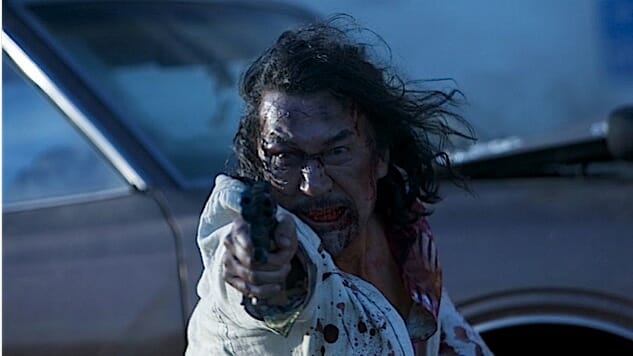
The rapid-fire montage sequence that opens The World of Kanako establishes the film’s sordid milieu. Picture-postcard shots of Tokyo on Christmas Eve are juxtaposed with gruesomely violent images; a character’s whisper of “I love you” is immediately followed by another character’s shout of “I’ll kill you”; moments of spirituality and communion are contrasted with flashes of suffering and death. Through it all, César Franck’s “Panis Angelicus” plays on the soundtrack, emphasizing the romantic moments while offering a starkly ironic counterpoint to the squalid bits. In his adaptation of a novel by Akio Fukamachi, director/co-writer Tetsuya Nakashima thus conjures up a world in which surface beauty masks an ocean of moral rot—represented, we gradually learn, by the title character (Nana Komatsu), who is, to put it mildly, quite a piece of work.
Initially, it appears as if Kanako is yet another “little girl lost,” an innocent corrupted by an evil, uncaring world; certainly, the film’s repeated references to Lewis Carroll’s Alice’s Adventures in Wonderland suggest as much. But as the film wades deeper into the muck, this turns out to not be the case at all. Instead, it is Kanako who turns out to be the evil one: a sociopath who is willing to say and do anything in order to make people do her bidding. Sweet-talking lonely teenage boys into falling in love with her before thrusting them into unwitting prostitution turns out to be the least of her offenses.
This twist marks The World of Kanako as a kind of perverted inverse of David Lynch’s Twin Peaks: Fire Walk With Me, another chronicle of a young girl’s harrowing descent into a self-destructive abyss. But while Lynch showed genuine empathy for Laura Palmer on her horrifying last hours on earth, Nakashima evinces no particular interest in understanding how Kanako got to this point beyond vague notions of parental neglect and blood lineage. Instead, she is treated as basically a walking symbol of amorality taken to a disturbing extreme, an empty shell without an ounce of recognizable humanity.
What saves Nakashima’s film, however, from being simply a sensationalistic exercise in taboo-busting is that it isn’t entirely about Kanako. The main character is, in fact, her father, Akikazu (Koji Yakusho), a down-in-the-dumps former detective who suddenly stumbles upon an opportunity for redemption when his ex-wife, Kiriko (Asuka Kurosawa), informs him that Kanako has gone missing and asks him to find her; it is through his bruised and battered eyes that we learn the truth about his daughter.
Akikazu, though, is hardly a saint himself. Early on, a close-up shot of handwriting in a notebook implies that he suffers from a mental illness of some sort (“shizophrenia/manic-depressive?”), for which he is seen taking pills. (Nakashima’s style—deliberately scattershot montages, ironic soundtrack cues with the volume pitched so low that they become the equivalent of musical wallpaper, an opening-credits sequence with retro graphics that look like something out of a 1960s yakuza thriller—suggest an attempt on his part to inhabit Akikazu’s twisted mental state.) Beyond his possible psychosis, however, he is an often sputtering ball of rage and resentment, so filled with disgust for all the vice he witnesses in the people around him that he can’t help but express it in the most extravagant of ways: wanton torture, attempts at vehicular homicide, and even rape. (Consider him Robert Ryan’s Jim Wilson in On Dangerous Ground taken to an ultra-violent zenith.)
And yet, a genuine sense of regret underpins even his most appalling actions. Having inadvertently pushed away his family as a result of his monstrous behavior, Akikazu sees this search for his daughter—who he never really got to know, being too busy squabbling with his cheating ex-wife—as an attempt to make amends. The fact that the terminally heartless Kanako is ultimately not worth Akikazu’s trouble doesn’t hinder him in the slightest; “I want to hit her with my own hands,” he at one point cries out, a motivation that is as much about restoring his impaired macho pride as about regaining a sense of normalcy in his life.
If The World of Kanako is ultimately difficult to wholly dismiss as simply an extended wallow in escalating unpleasantness, much of this can be credited to Koji Yakusho’s performance. Certainly, Yakusho—like the filmmaker himself—doesn’t hold back in characterizing Akikazu as the crazy bastard he is … but there’s genuine pathos in his piercing cries of despair, a deep understanding of fatherly pain that locates the inner humanity in this sick soul. When, at the end, the film essentially encases its antihero in a wintry psychological purgatory of his own creation, Yakusho’s soulful gravity helps give his final freeze-frame a tragic grandeur that perhaps transcends even Nakashima’s own intentions.
Director: Tetsuya Nakashima
Writer: Akio Fukamachi (based on the novel by); Tetsuya Nakashima, Miako Tadano, Nobuhiro Monma (screenplay)
Starring: Kôji Yakusho, Nana Komatsu , Satoshi Tsumabuki
Release Date: Dec. 4, 2015
Kenji Fujishima is a freelance film critic, contributing to Slant Magazine, Brooklyn Magazine, The Playlist, The Village Voice and Paste. He is also Deputy Editor of Movie Mezzanine and former editor-in-chief of In Review Online. When he’s not watching movies and writing and editing film criticism, he’s trying to absorb as much music, art, and literature as possible. He has not infrequently been called a “culture vulture” for that reason.